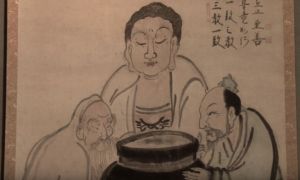On view at LACMA from May 22, 2011–August 14, 2011, Hakuin Ekaku (1685-1768) is widely acknowledged as the most important Zen Buddhist master of the past 500 years. He was also the most influential Zen artist of Edo-period (1615-1868) Japan, but unlike the highly studied monk painters of earlier centuries, he received no formal artistic training beyond the basic skills in handling brush, ink, and paper that were required for everyday writing.
Hakuin’s self-taught, spontaneous, yet masterly and inspired painting and calligraphy, just like his teachings and writings, expressed the mind and heart of Zen for monks and lay followers alike. With the aim of reaching out to people of all social and economic classes, rather than just the élite, he invented a new visual language for his religion, depicting everyday subjects and themes from other Buddhist sects, as well as Zen patriarchs and masters.
For this first exhibition in the West devoted to Hakuin, nearly 80 of his scrolls will be gathered from collections in the United States and Japan. Organized in collaboration with New Orleans Museum of Art, and curated by Audrey Yoshiko Seo and Professor Stephen Addiss. The Los Angeles presentation is made possible by LACMA’s East Asian Art Council.
For more information, visit lacma.org Video production: Alexa Oona Schulz
To view more of Hakuin’s paintings click here.
Categories: Art, Biography, Buddhism, Chan / Seon / Zen, Encyclopedia, History, Mahayana, News & events, Video, Zen Master Hakuin


I’m not sure Robert Singer’s reading of the painting showing the Buddha, Lao Tzu and Conficius is correct. He says tells us that no matter what religion we may be studying, be it Hinduism, Christianity, Judaism, ….etc at root they all have the same truth.
I may be wrong, but I think the artist is saying that Truth has the same flavour to anyone who actually tastes it, which is quite different from what Singer was saying.
The Buddha is shown having offered Lao Tzu and Confucius the wine of truth, neither of whom had tasted it in its fullest sense. Certainly not Confucius, though Lao Tzu was pretty close to it, and his views were widely incorporated into Chan buddhist imagery.
Fantastic! The LACMA video with the curator’s illuminating remarks is wonderful.
way too many words, not enough time to see what’s being spoken of
😎 Because truth is beyond words, we can use as many words as we wish 😀
R
Beautiful art and deep wisdom! Thankyou for sharing. 🙏🏻